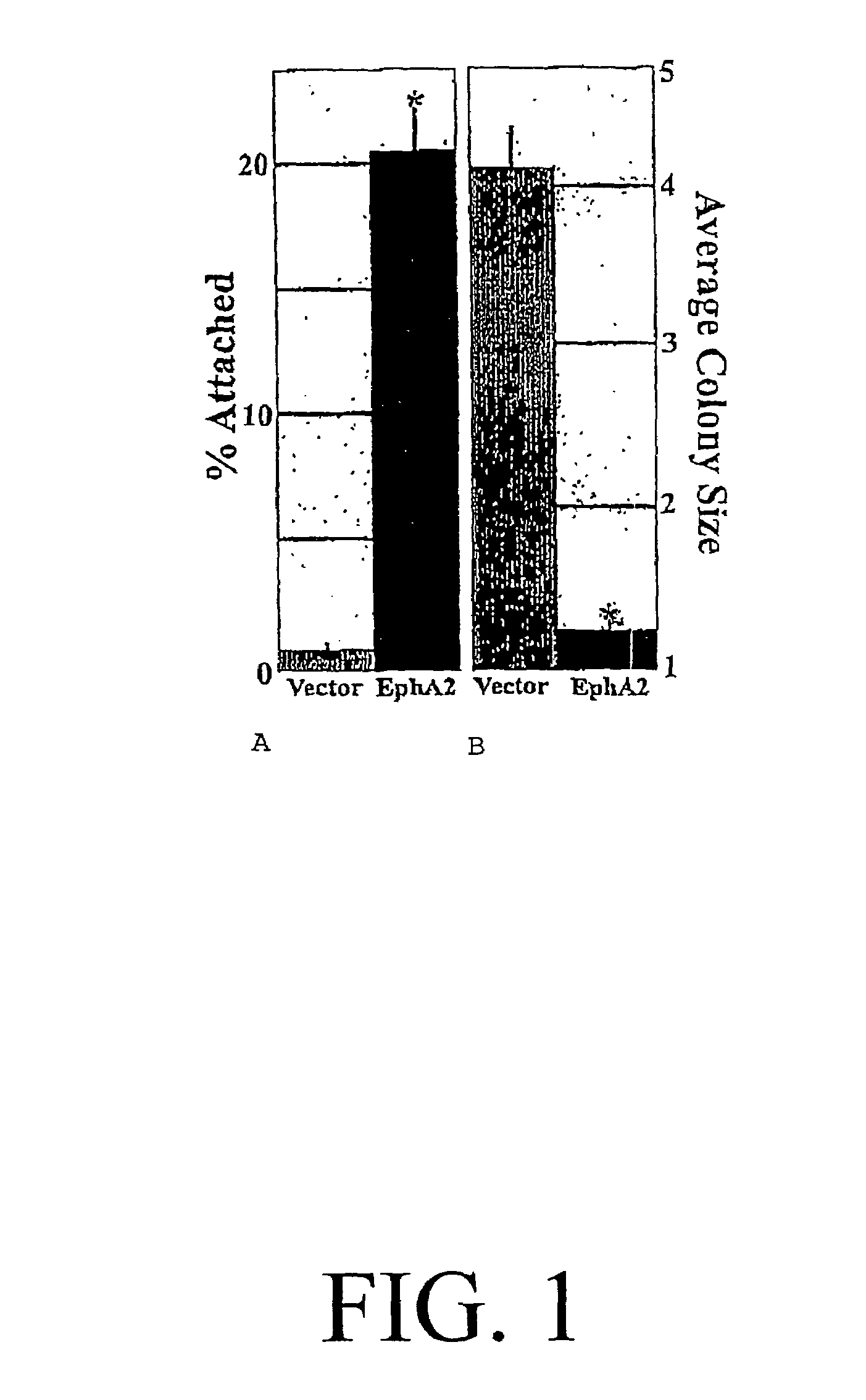EphA2 monoclonal antibodies and methods of making and using same
a monoclonal antibody and antibody technology, applied in the field of epha2 monoclonal antibodies and methods of making and using same, can solve the problems of compromising the growth and unable to exploit important differences between normal and metastatic cells, and affecting the survival of benign cells, so as to achieve the effect of conferring metastatic potential
- Summary
- Abstract
- Description
- Claims
- Application Information
AI Technical Summary
Benefits of technology
Problems solved by technology
Method used
Image
Examples
example 1
E-Cadherin Regulates the Function of the EphA2 Receptor Tyrosine Kinase
[0065]The localization and phosphorylation of EphA2 in mammary epithelial cells was dependent on E-cadherin-mediated adhesion and that loss of E-cadherin in metastatic tumor cells causes alterations in EphA2 localization and phosphorylation. In addition, the experimental induction of EphA2 phosphorylation decreased cell-ECIVI attachment at focal adhesions and negatively regulated the proliferation of metastatic cells.
[0066]Cell Lines and Antibodies
[0067]Human breast carcinoma cells and non-transformed human marrimary epithelial cell lines were cultured as described previously (Kinch. M. S., et al. E-cadherin engagement stimulates tyrosine phosphorylation. Cell Adhes. Commun., 4: 425-437, 1997; Bale. S. N., Molecular and cellular analysis of basement membrane Invasion by human breast cancer cells in Matrigal-based in vitro assays. Breast Cancer Res. Treat, 24: 241-255, 1993). We purchased antibodies specific for E...
example 2
EphA2 Overexpression Causes Tumorigenesis and Metastasis of Mammary Epithelial Cells
[0115]Elevated levels of protein tyrosine phosphorylation contribute to a malignant phenotype, although the kinases that are responsible for this signaling remain largely unknown. This example shows increased levels of the EphA2 protein tyrosine kinase were present in cell models and clinical specimens of breast cancer. EphA2 overexpression was sufficient to confer malignant transformation and metastatic potential upon non-transformed (MCF-10A) mammary epithelial cells. The transforming capacity of EphA2 was related to its ability to control cellular adhesions and with the failure of EphA2 to interact with its cell-attached ligands. Interestingly, stimulation of EphA2 was sufficient to reverse the malignant growth and invasiveness of EphA2-transformed cells. Altogether, these results identified EphA2 as a powerful oncoprotein in breast cancer.
Cells and Antibodies
[0116]All cells were cultured as descr...
example 3
Activation-Dependent Proteolysis of EpbAZ
[0148]Activation of EphA2 with EphrinA 1-Fc or monoclonal antibodies induces EphA2 proteolysis. Most EphA2 on metastatic cells (>90%) is degraded within 1-2 hours. The mechanism of this proteolysis involves direct interactions with the Cb1 adapter protein, which directs EphA2 to be degraded by proteosomal or lysosomal enzymes. These findings have important implications for understanding causes of EphA2 overexpression in cancer cells (e.g., decreased ligand binding increases protein stability) as a target for cancer therapy.
PUM
| Property | Measurement | Unit |
|---|---|---|
| concentration | aaaaa | aaaaa |
| concentration | aaaaa | aaaaa |
| median volume | aaaaa | aaaaa |
Abstract
Description
Claims
Application Information
 Login to View More
Login to View More - R&D
- Intellectual Property
- Life Sciences
- Materials
- Tech Scout
- Unparalleled Data Quality
- Higher Quality Content
- 60% Fewer Hallucinations
Browse by: Latest US Patents, China's latest patents, Technical Efficacy Thesaurus, Application Domain, Technology Topic, Popular Technical Reports.
© 2025 PatSnap. All rights reserved.Legal|Privacy policy|Modern Slavery Act Transparency Statement|Sitemap|About US| Contact US: help@patsnap.com

